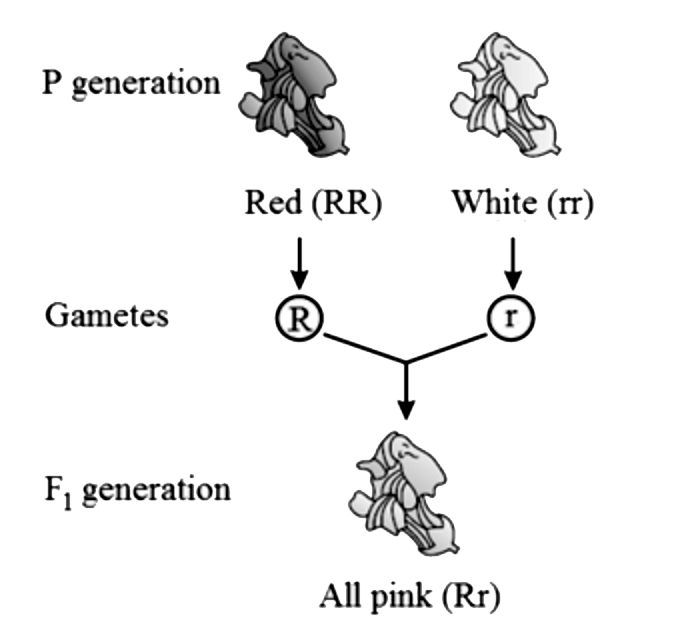The nheritance of flower colour in the dog flower (snapdragon or antirrhium sp./) is a good example of
codominance
incomplete dominance
multiple allele
complete dominance
The correct Answer is:B
Step-by-Step Solution:
1. Understanding the Question: The question asks about the inheritance pattern of flower color in the dog flower (snapdragon or Antirrhinum species).
2. Identifying the Options: The options given are:
- Co-dominance
- Incomplete dominance
- Multiple alleles
- Complete dominance
3. Analyzing Flower Color Inheritance in Snapdragon:
- In snapdragons, when red-flowered plants are crossed with white-flowered plants, the resulting offspring (F1 generation) exhibit a pink flower color.
- This indicates that neither the red nor the white allele is completely dominant over the other.
4. Defining Incomplete Dominance:
- Incomplete dominance occurs when the phenotype of the heterozygote (F1 generation) is intermediate between the phenotypes of the two homozygotes (the parents).
- In this case, the red (R) and white (r) alleles blend to produce pink (Rr) flowers.
5. Conclusion: Based on the analysis, the inheritance of flower color in snapdragons is a good example of incomplete dominance.
6. Final Answer: The inheritance of flower color in the dog flower (snapdragon) is a good example of incomplete dominance.
---
- Co-dominance
- Incomplete dominance
- Multiple alleles
- Complete dominance
- In snapdragons, when red-flowered plants are crossed with white-flowered plants, the resulting offspring (F1 generation) exhibit a pink flower color.
- This indicates that neither the red nor the white allele is completely dominant over the other.
- Incomplete dominance occurs when the phenotype of the heterozygote (F1 generation) is intermediate between the phenotypes of the two homozygotes (the parents).
- In this case, the red (R) and white (r) alleles blend to produce pink (Rr) flowers.
Similar Questions
Inheritance of flower colour in Mirabilis jalapa is an example of:
View SolutionIn the case of snapdragon (Antirrhinum majus) a plant with red flowers was crossed with another plant with white flowers. Trace the inheritance of flower colour up to the F2 generation indicating the genotypes and phenotypes at each level. What special features do you notice in the genotypic and phenotypic ratio in F1 generations?
View Solution
Knowledge Check
- Question 1 - Select One
The inheritance of flower colour in Antirrhinum (dog flower) is an example of
Aincomplete dominanceBcodominanceCmultiple allelesDlinkage - Question 2 - Select One
The inheritance of flower colour in Antirrhinum (dog flower) is an example of
 Aincomplete dominanceBcodominanceCmultiple allelesDlinkage
Aincomplete dominanceBcodominanceCmultiple allelesDlinkage - Question 3 - Select One
In athe inheritance of flower colour in dog flower plant, the F1 had a phenotype that
AResembles both of the parentsBDid not resembles either of the two parentsCResembles with only one parentDBoth (a) and (c )
Inheritance pattern of flower colour in garden pea plant and snapdragon differs. Why is tlris difference observed? Explain showing the crosses up to F2 generation.
View SolutionIn athe inheritance of flower colour in dog flower plant, the F1 had a phenotype that
View SolutionExamples of water pollinated floweres are
View SolutionInheritance of flower colour is an example of incomplete dominance, which is seen in
View SolutionIn fruits and flowers, colour pigments are located in
View Solution

